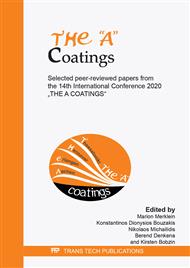[1]
K. Bobzin, High performance coatings for cutting tools, CIRP Journal of Manufacturing Science and Technology, Vol 18, 2017, pp.1-9.
DOI: 10.1016/j.cirpj.2016.11.004
Google Scholar
[2]
T. Krieg, Eigenschaftsprofile von PVD-Werkzeugbeschichtungen für den Einsatz von umweltverträglichem Kühlschmierstoff beim Drehen und Bohren von Stahlwerkstoffen, Dr.-Ing. Dissertation, Aachen, (2001).
Google Scholar
[3]
R. M'Saoubi, H. Chandrasekaran: Investigation of the effects of tool micro-geometry and coating on tool temperature during orthogonal turning of quenched and tempered steel, International Journal of Machine Tools & Manufacture 44, 2004, pp.213-224.
DOI: 10.1016/j.ijmachtools.2003.10.006
Google Scholar
[4]
D. Kammermeier, Charakterisierung von binären und ternären Hartstoffschichten anhand von Simulations- und Zerspanuntersuchungen, Dr.-Ing. Dissertation, Aachen, (1992).
Google Scholar
[5]
I. S. Jawahir, C. A. van Luttervelt, Recent Developments in Chip Control Research and Applications. CIRP Annals, Vol. 42, Issue 3, 1993, pp.659-693.
DOI: 10.1016/s0007-8506(07)62531-1
Google Scholar
[6]
W. Grzesik, The Influence of thin hard coatings on frictional behavior in the orthogonal cutting process, Tribology International 33, 2000, pp.131-140.
DOI: 10.1016/s0301-679x(00)00072-4
Google Scholar
[7]
F. Kone, B. Czarnota, B. Haddag, M. Nouari, Finite element modelling of the thermo-mechanical behavior of coatings under extreme contact loading in dry machining, Surface & Coatings Technology 205, 2011, pp.3559-3566.
DOI: 10.1016/j.surfcoat.2010.12.024
Google Scholar
[8]
I. Krajinovic, W. Daves, M. Tkadletz, T. Teppernegg, T. Klüsner, N. Schalk, C. Mitterer, C. Tritremmel, W. Ecker, C. Czettl, Finite element study of the influence of hard coatings on hard metal tool loading during milling, Surface & Coatings Technology 304, 2016, pp.134-141.
DOI: 10.1016/j.surfcoat.2016.06.041
Google Scholar
[9]
Y.C. Yen, A. Jain, P. Chigurupati, W.T. Wu, T. Altan, Computer simulation of orthogonal cutting using a tool with multiple coatings, Machining Science and Technology 8, 2004, pp.305-326.
DOI: 10.1081/mst-200029230
Google Scholar
[10]
J. Rech, J. L. Battaglia, A. Moisan, Thermal influence of cutting tool coatings. J. Phys. IV France 120, 2004, pp.743-750.
DOI: 10.1051/jp4:2004120086
Google Scholar
[11]
A. Kusiak, J. L. Battaglia, J. Rech, Tool coatings influence on the heat transfer in the tool during machining. Surface and Coatings Technology 195/1-2, 2006, pp.29-40.
DOI: 10.1016/j.surfcoat.2005.01.007
Google Scholar
[12]
J. Martan, P. Benes, Thermal properties of cutting tool coatings at high temperatures, Thermochimica Acta, 539, 2012, pp.51-55.
DOI: 10.1016/j.tca.2012.03.029
Google Scholar
[13]
B. Tlili, N. Mustapha, C. Nouveau, Y. Benlatreche, G. Guillemot, M. Lambertin, Correlation between thermal properties and aluminum fractions in CrAlN layers deposited by PVD technique, Vacuum, 84/9, 2010, pp.1067-1074.
DOI: 10.1016/j.vacuum.2010.01.011
Google Scholar
[14]
B. Denkena, A. Lucas, E. Bassett, Effects of the cutting edge microgeometry on tool wear and its thermo-mechanical load, CIRP Annals - Manufacturing Technology 60, No. 1, 2011, pp.73-76.
DOI: 10.1016/j.cirp.2011.03.098
Google Scholar
[15]
B. Müller, Thermische Analyse des Zerspanens metallischer Werkstoffe bei hohen Schnittgeschwindigkeiten, Dr.-Ing. Dissertation., Rheinisch-Westfälische Technische Hochschule Aachen, (2004).
Google Scholar
[16]
S. Beblein, B. Breidenstein, B. Denkena, On the thermal insulation effect of PVD-AlCrN-coated cutting tools in continuous turning of AlSl 4140, 13th THE-A-Coatings,, 5-6 October 2017, pp.53-61.
Google Scholar
[17]
K. Pantke, Entwicklung und Einsatz eines temperatursensorischen Beschichtungssystems für Zerspanwerkzeuge, Dr.-Ing. Dissertation, TU Dortmund, (2011).
Google Scholar


